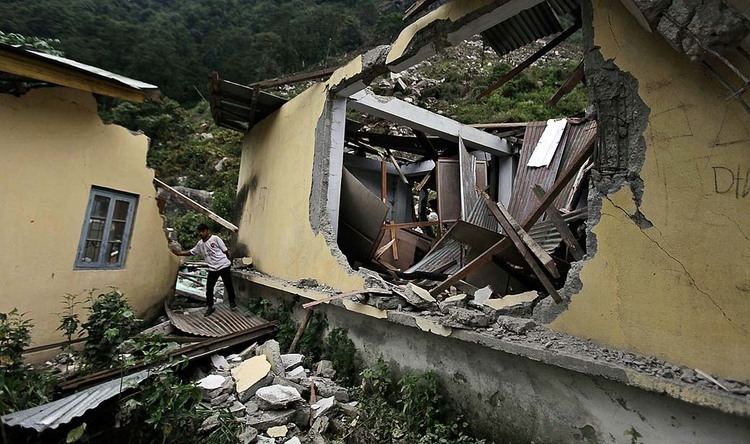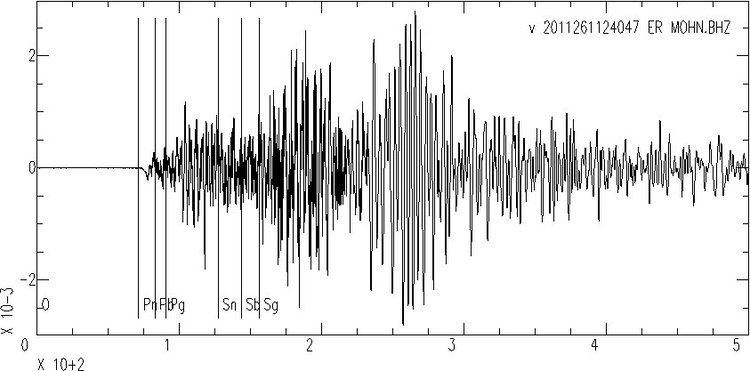Duration 30–40 seconds Depth 19.7 km (12.1 mi) Date 18 September 2011 | Magnitude 6.9 (Mw) | |
 | ||
Origin time 18:10 IST (UTC+05:30)18:25 NPT (UTC+05:45)18:40 BTT (UTC+06:00)20:40 CST (UTC+08:00) Areas affected IndiaBangladeshNepalBhutanChina Similar | ||
September 18th 2011 sikkim earthquake
The 2011 Sikkim earthquake (also known as the 2011 Himalayan earthquake) occurred with a moment magnitude of 6.9 and was centered within the Kanchenjunga Conservation Area, near the border of Nepal and the Indian state of Sikkim, at 18:10 IST on Sunday, 18 September. The earthquake was felt across northeastern India, Nepal, Bhutan, Bangladesh and southern Tibet.
Contents
- September 18th 2011 sikkim earthquake
- Earthquake
- Intensity
- Aftershocks
- Impact
- India
- Sikkim
- Nepal
- Bangladesh
- China
- Bhutan
- Rescue operations and compensation
- References
At least 111 people were killed in the earthquake. Most of the deaths occurred in Sikkim, with reports of fatalities in and near Singtam in the East Sikkim district. Several buildings collapsed in Gangtok. Eleven are reported dead in Nepal, including three killed when a wall collapsed in the British Embassy in Kathmandu. Elsewhere, structural damage occurred in Bangladesh, Bhutan, and across Tibet; another seven fatalities were confirmed in the latter region.

The quake came just a few days after an earthquake of 4.2 magnitude hit Haryana's Sonipat district, sending tremors in New Delhi. The earthquake was the fourth significant earthquake in India of September 2011.

Exactly a year after the original earthquake at 5:55 pm on 18 September 2012, another earthquake of magnitude 4.1 struck Sikkim, sparking panic among the people observing the anniversary of the original quake.

Earthquake

The magnitude 6.9 (Mw) earthquake occurred inland at 18:10 IST on 18 September 2011, about 68 km (42 mi) northwest of Gangtok, Sikkim at a shallow depth of 19.7 km (12.2 mi). At its location, the continental Indian and Eurasian Plates converge with one another along a tectonic boundary beneath the mountainous region of northeast India near the Nepalese border. Although earthquakes in this region are usually interplate in nature, preliminary data suggests the Sikkim earthquake was triggered by shallow strike-slip faulting from an intraplate source within the over-riding Eurasian Plate. Initial analyses also indicate a complex origin, with the perceived tremor likely being a result of two separate events occurring close together in time at similar focal depths.
Intensity

Located at a shallow depth beneath the surface, the earthquake caused strong shaking in many areas adjacent to its epicenter reportedly lasting 30 – 40 seconds. The strongest shaking occurred to the west in Gangtok and further south in Siliguri, although similar ground motions registering at MMVI (strong) on the Mercalli scale were recorded in many smaller towns such as Mangan across elevated regions. Lighter tremors (MMIV – III) spread southward through populous regions, with these motions reported in the Patna capital of Bihar and as far southwest as Bihar Sharif. In all, the earthquake was felt in Nepal, India, Bhutan, Bangladesh and China. Tremors were felt in Assam, Meghalaya, Tripura, parts of West Bengal, Bihar, Jharkhand, Uttar Pradesh, Rajasthan, Chandigarh and Delhi states of India. In Tibet, the earthquake was felt in Shigatse and Lhasa.
Aftershocks
Sikkim experienced three aftershocks since the earthquake, occurring at magnitudes of 5.7, 5.1, and 4.6 (Mw) within 30 minutes of the initial earthquake. Kathmandu experienced two aftershocks that both had a magnitude of 4.8 Mw. The aftershocks had no serious impact in the region. At least 20 aftershocks back-to-back throughout the night created panic in the Gangtok. On 19 September, tremors shook some parts of Maharashtra measuring 3.9 (Mw) at around 06:30 IST including Latur, Osmanabad and Solapur districts, all of which had already suffered the 1993 earthquake. However, no loss of life or property was reported.
Impact
The earthquake struck near a mountainous, albeit very populous region near the Sikkim–Nepal border; most of the structures were reported to be highly vulnerable to earthquake shaking. Upon impact, tens of thousands of residents evacuated their homes, and many areas suffered from communication and power outages. The strong shaking caused significant building collapse and mudslides; at least 111 people were confirmed killed by the effects of the earthquake, and hundreds of others sustained injuries. As the earthquake occurred in the monsoon season, heavy rain and landslides rendered rescue work more difficult.
India
Northern India suffered the most from the earthquake, with at least 75 people killed. 60 people were reportedly killed in Sikkim alone. At least 7 people have died in Bihar, while 6 deaths have been reported from West Bengal. Power supply was disrupted in areas near Sikkim, including Kalimpong of Darjeeling district, and adjoining Jalpaiguri and Cooch Behar districts; the outages were in part blamed on an affected electric substation in Siliguri. Water supply was interrupted in Sikkim. National Highway 31, the major highway linking Sikkim to the rest of India, was damaged. Ten of the dead were workers at a hydroelectric project on the Teesta River.
In India, property damage is estimated to be around ₹1,000 billion (US$15 billion) with the actual report yet to come.
Sikkim
Two buildings of the Indo-Tibetan Border Police in the Pegong areas of North Sikkim collapsed. In Gangtok, many government offices and hospitals were left unusable. The heavy shaking destroyed the villages of Lingzya, Sakyong, Pentong, Bay and Tholong.
Nepal
In the capital city of Nepal, Kathmandu, damage from the earthquake was comparatively limited. Three people were killed when a wall at the British Embassy collapsed, and many others suffered injuries. The shaking effects were more severe in eastern Nepal, which is closer to the epicenter. There, hundreds of homes sustained significant damage, and due to saturated soil from preceding heavy rains widespread mudslides impacted the region. Sunsari experienced power and telephone communication outages. Two people were killed in the eastern city of Dharan. Overall, in Nepal 6 people died due to the earthquake.
Bangladesh
The earthquake was felt most strongly in northern Bangladesh. The quake was also felt in Dhaka, Rajshahi, Sylhet, Mymensingh, Barisal, Faridpur, Jessore, Khulna, Pabna, Bogra, Comilla, Noakhali, Chittagong and as far as Cox's Bazar. Panicked people rushed out of their homes and offices, but the only damage seems to be tilted and cracked buildings; no casualties were reported. Cell phone lines were also down for a few minutes during the quake.
China
In Tibet, building collapse was reported in Yadong, Dinggyê and Gamba. At least seven people were reported dead in Yadong. Telephone service was interrupted in the seat of Yadong County.
Bhutan
There were no reports of casualties in Bhutan, although cracks on walls and ceilings of houses were reported in Wangthangkha village, Lango and the town area in Paro. There were also reports of a landslide right after crossing the Isuna Bridge from Paro towards Thimphu, and falling boulders after crossing Chundzom Bridge. Citizens were asked to avoid traveling on the Paro-Thimphu highway. Telecommunications networks were disrupted, with cellular networks unavailable after the quake.
Prime Minister of Bhutan Jigmi Thinley updated in his status as "Phone lines remains clogged reflecting our caring and close knit society. No damage reported from East Bhutan. Four road blocks caused by falling debris are reported on the Chukha - Phuntsholing road. Two homes in Haa report damage with 3-4 people having suffered minor injury. Thimphu Dzong has sustained some cracks in the Utse and one of the four corner towers. Occupants have been moved out to safer parts. Please remain calm and alert."
Rescue operations and compensation
Early rescue operations included four teams of National Disaster Response Force been rushed to Sikkim and five more teams were being sent from Kolkata. However, South and West Sikkim remained inaccessible delaying rescue operations owing to landslides caused by rainfall. A group of 14 tourists were rescued by the army from north Sikkim. The army had deployed 72 columns including infantry troops, combat engineers, four Dhruv and five Cheetah helicopters. Rain and landslides had hampered the rescue efforts of workers searching for survivors.
Indian Prime Minister Dr. Manmohan Singh, on 19 September, announced ₹200,000 (US$3,000) as ex-gratia to a family member of those killed in the earthquake and ₹100,000 (US$1,500) for seriously injured. ₹50,000 (US$740) for those grievously injured and ₹25,000 (US$370) for those with minor injuries was announced by Sikkim chief minister Pawan Chamling.
